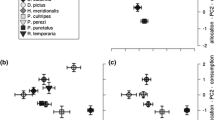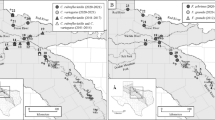Abstract
Larval anuran communities vary along a gradient of pond permanency. The families Hylidae, Ranidae, and Bufonidae have each diversified into multiple pond types. Species using ponds that dry seasonally (vernal ponds) must compete well to metamorphose before pond drying, while permanent ponds, which contain more predators, produce weaker selection for competitive ability. Quantifying phenotypic traits related to resource acquisition in 14 anuran species provides insight into the mechanistic underpinnings of adaptive radiation in anuran lineages. Under controlled laboratory conditions and at both early and late developmental stages, relative growth rate, relative consumption rate, assimilation efficiency and production efficiency varied significantly among species. As predicted, vernal pond species had high growth rates relative to species using more than one pond type. However, within a pond type, families frequently differed in phenotype. In species using permanent ponds with fish predators, hylids had high growth rates while ranids had low growth rates, and in species using vernal ponds, bufonids had higher assimilation efficiencies than hylids. Differences also occurred between stages; hylids and ranids in permanent, but fishless, ponds were similar at an early stage, but late stage hylids in the same pond type had lower growth and consumption rates, and higher assimilation efficiencies than ranids. Functional relationships between phenotypic traits also differed among species and developmental stage. Negative correlations between evolutionary change (independent contrast values) in both mass and growth rate (both stages), and mass and consumption rate (late stage), suggest the presence of trade-offs. These results indicate that different lineages have diversified in different ways into the same pond types.
Similar content being viewed by others
References
Altig, R. and Kelly, J.P. (1974) Indices of feeding in anuran tadpoles as indicated by gut characteristics. Herpetologica 30, 200–203.
Altig, R. and McDearman, W. (1975) Percent assimilation and clearance times of five anuran tadpoles. Herpetologica 31, 67–69.
Anholt, B.R. and Werner, E.E. (1995) Interaction between food availability and predation mortality mediated by adaptive behavior. Ecology 76, 2230–2334.
Arendt, J.D. (1997) Adaptive intrinsic growth rates: an integration across taxa. Q. Rev. Biol. 72, 149–177.
Arnold, S.J. (1992) Constraints on phenotypic evolution. Am. Nat. 140, S85–S107.
Collins, J.P. and Wilbur, H.M. (1979) Breeding habits and habitats of the amphibians of the Edwin S. George Reserve, Michigan, with notes on the local distributions of fishes. Occ. Pap. Mus. Zool. Univ. Michigan 686, 1–34.
Conover, R.J. (1966) Assimilation of organic matter by zooplankton. Limnol. & Oceanogr. 12, 338–345.
Demment, M.W. and van Soest, P.J. (1985) A nutritional explanation for body-size patterns of ruminant and nonruminant herbivores. Am. Nat. 125, 641–672.
Duellman, W.E. and Trueb, L. (1994) Biology of Amphibians. Johns Hopkins University Press, Baltimore, MD.
Díaz-Uriarte, R. and Garland, T. Jr. (1996) Testing hypotheses of correlated evolution using phylogenetically independent contrasts: sensitivity to deviations from Brownian motion. Syst. Biol. 45, 27–47.
Díaz-Uriarte, R. and Garland, T. Jr. (1998) Effects of branch length errors on the performance of phylogenetically independent contrasts. Syst. Biol. 47, 654–672.
Du, W-G., Xan, S-J. and Ji, X. (2000) Selected body temperature, thermal tolerance and thermal dependence of food assimilation and locomotor performance in adult blue-tailed skinks, Eumeces elegans. J. Therm. Biol. 25, 197–202.
Felsenstein, J. (1985) Phylogenies and the comparative method. Am. Nat. 125, 1–15.
Felsenstein, J. (1988) Phylogenies and quantitative characters. Ann. Rev. Ecol. Syst. 19, 445–471.
Gittleman, J.L. and Luh, H.-K. (1992) On comparing comparative methods. Ann. Rev. Ecol. Syst. 23, 383–404.
Gosner, N. (1960) A simplified table for staging anuran embryos and larvae with notes on identification. Herpetologica 16, 183–190.
Graybeal, A. (1997) Phylogenetic relationships of bufonid frogs and tests of alternate macroevolutionary hypotheses characterizing their radiation. Zool. J. Linn. Soc. 119, 297–338.
Harvey, P.H. and Pagel, M.D. (1991) The Comparative Method in Evolutionary Biology. Oxford University Press, Oxford.
Hawkins, A.J.S., Bayne, B.L., Bougrier, S., Héral, M., Iglesias, J.I.P., Navarro, E., Smith, R.F.M. and Urrutia, M.B. (1998) Some general relationships in comparing the feeding physiology of suspension-feeding bivalve molluscs. J. Exp. Mar. Biol. Ecol. 219, 87–103.
Hayduk, L.A. (1988) Structural Equation Modeling with Lisrel: Essentials and Advances. Johns Hopkins University Press, Baltimore, MD.
Hedges, S.B. (1986) An electrophoretic analysis of holarctic hylid frog evolution. Syst. Zool. 35, 1–21.
Hillis, D.M. and Davis, S.K. (1986) Evolution of ribosomal DNA: fifty million years of recorded history in the frog genus Rana. Evolution 40, 1275–1288.
Huey, R.B. (1987) Phylogeny, history, and the comparative method. In M.E. Feder, A.F. Bennett, W.W. Burggren and R.B. Huey (eds) New Directions in Ecological Physiology. Cambridge University Press, Cambridge, pp. 76–98.
Lawler, S.P. (1989) Behavioural responses to predators and predation risk in four species of larval anurans. Anim. Behav. 38, 1039–1047.
Leips, J. and Travis, J. (1994) Metamorphic responses to changing food levels in two species of hylid frogs. Ecology 75, 1345–1356.
Li, C.C. (1975) Path Analysis: A Primer. Boxwood, Pacific Grove, CA.
Lima, S.L. (1998) Stress and decision-making under the risk of predation: recent developments from behavioral, reproductive, and ecological perspectives. Adv. Study Behavior 27, 215–290.
Losos, J.B. (1990) Concordant evolution of locomotor behaviour, display rate and morphology in Anolis lizards. Anim. Behav. 39, 879–890.
Losos, J.B. (1992) The evolution of convergent structure in Caribbean Anolis communities. Syst. Biol. 41, 403–420.
Losos, J.B. (1994) An approach to the analysis of comparative data when a phylogeny is unavailable or incomplete. Syst. Biol. 43, 117–123.
Losos, J.B., Jackman, T.R., Larson, A., de Queiroz, K. and Rodríguez-Schettino, L. (1998) Contingency and determinism in replicated adaptive radiations of island lizards. Science 279, 2115–2118.
Manly, B.F.J. (1991) Randomization and Monte Carlo Methods in Biology. Chapman & Hall, New York.
MacDonald, B.A., Bacon, G.S. and Ward, J.E. (1998) Physiological responses of infaunal (Mya arenaria) and epifaunal (Placopecten magellanicus) bivalves to variations in the concentration and quality of suspended particles II. Absorption efficiency and scope for growth. J. Exp. Mar. Biol. Ecol. 219, 127–141.
Martins, E.P. (1996) Conducting phylogenetic comparative studies when the phylogeny is not known. Evolution 50, 12–22.
Martins, E.P. and Garland, T.G. (1991) Phylogenetic analyses of the correlated evolution of continuous characters: a simulation study. Evolution 45, 534–557.
McPeek, M.A. (1990a) Determination of species composition in the Enallagma damselfly assemblages of permanent lakes. Ecology 71, 83–98.
McPeek, M.A. (1990b) Behavioral differences between Enallagma species (Odonata) influencing differential vulnerability to predators. Ecology 71, 1714–1726.
McPeek, M.A. (1995) Testing hypotheses about evolutionary change on single branches of a phylogeny using evolutionary contrasts. Am. Nat. 145, 686–703.
McPeek, M.A. (1998) The consequences of changing the top predator in a food web: a comparative experimental approach. Ecol. Monogr. 68, 1–23.
McPeek, M.A., Schrot, A.K. and Brown, J.M. (1996) Adaptation to predators in a new community: swimming performance and predator avoidance in damselflies. Ecology 77, 617–629.
Morin, P.J. (1981) Predatory salamanders reverse the outcome of competition among three species of anuran tadpoles. Science 212, 1284–1286.
Morin, P.J. (1983) Predation, competition, and the composition of larval anuran guilds. Ecol. Monogr. 53, 119–138.
Newman, R.A. (1987) Effects of density and predation on Scaphiopus couchi tadpoles in desert ponds. Oecologia 71, 301–307.
Post, T.J. and Uzzell, T. (1981) The relationships of Rana sylvatica and the monophyly of the Rana boylii group. Syst. Zool. 30, 170–180.
Price, T. (1997) Correlated evolution and independent contrasts. Phil. Trans. R. Soc. Lond. B. 352, 519–529.
Saidapur, S.K. and Girish, S. (2001) Growth and metamorphosis of Bufo melanostictus tadpoles: effects of kinship and density. J. of Herpetology 35, 249–254.
Savage, J.M. (1973) The geographic distribution of frogs: patterns and predictions. In J.L. Vial (ed) Evolutionary Biology of the Anurans. University of Missouri Press, Columbia, MO, pp. 351–455.
Seale, D.B. (1987) Amphibia. In T.J. Pandian and F.J. Veraberg (eds) Animal Energetics, vol. 2. Academic Press, San Diego, CA, pp. 467–552.
Seale, D.B. and Beckvar, N. (1980) The comparative ability of Anuran larvae (Genera: Hyla, Bufo, and Rana) to ingest suspended blue-green algae. Copeia 1980, 495–503.
Searle, S.R. (1987) Linear Models for Unbalanced Data. New York: Wiley & Sons.
Semlitsch, R.D., Scott, D.E., Pechman, J.H.K. and Gibbons, J.W. (1996) Structure and dynamics of an amphibian community. In M.L. Cody and J.A. Smallwood (eds) Long-term Studies of Vertebrate Communities. Academic Press, San Diego, CA, pp. 217–248.
Skelly, D.K. (1996) Pond drying, predators, and the distribution of Pseudacris tadpoles. Copeia 1996, 599–605.
Skelly, D.K. (1997) Tadpole communities. Am. Sci. 85, 36–45.
Sokal, R.R. and Rohlf, F.J. (1995) Biometry: The Principles and Practice of Statistics in Biological Research. 3rd edn. W.H. Freeman and Company, New York.
Steinwascher, K. and Travis, J. (1983) Influence of food quality and quantity on early larval growth of two anurans. Copeia 1983, 238–242.
Taylor, C.L., Altig, R. and Boyle, C.R. (1995) Can anuran tadpoles choose among foods that vary in quality? Alytes 13, 81–86.
Travis, J. (1980) Genetic variation for larval specific growth rate in the frog Hyla gratiosa. Growth 44, 167–181.
Travis, J. (1983) Variation in growth and survival of Hyla gratiosa larvae in experimental enclosures. Copeia 1983, 232–237.
Wassersug, R.J. (1972) The mechanism of ultraplanktonic entrapment in anuran larvae. J. Morphology 137, 279–288.
Wellborn, G.A., Skelly, D.K. and Werner, E.E. (1996) Mechanism creating community structure across a freshwater habitat gradient. Ann. Rev. Ecol. Syst. 27, 337–363.
Werner, E.E. (1986) Amphibian metamorphosis: growth rate, predation risk, and the optimal size at transformation. Am. Nat. 128, 319–341.
Werner, E.E. (1994) Ontogenetic scaling of competitive relations: size-dependent effects and responses in two anuran larvae. Ecology 75, 197–213.
Werner, E.E. and McPeek, M.A. (1994) Direct and indirect effects of predators on two anuran species along an environmental gradient. Ecology 75, 1368–1382.
Wilbur, H.M. (1972) Competition, predation, and the structure of the Ambystoma-Rana sylvatica community. Ecology 53, 3–21.
Wilbur, H.M. (1980) Complex life cycles. Ann. Rev. Ecol. Syst. 11, 67–93.
Woodward, B.D. (1983) Predator-prey interactions and breeding-pond use of temporary-pond species in a desert anuran community. Ecology 64, 1549–1555.
Author information
Authors and Affiliations
Corresponding author
Rights and permissions
About this article
Cite this article
Richardson, J.M. A comparative study of phenotypic traits related to resource utilization in anuran communities. Evolutionary Ecology 16, 101–122 (2002). https://doi.org/10.1023/A:1016381122862
Issue Date:
DOI: https://doi.org/10.1023/A:1016381122862




